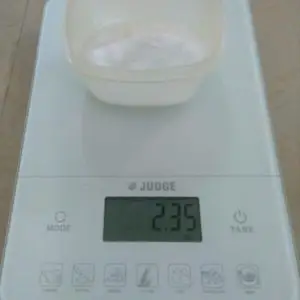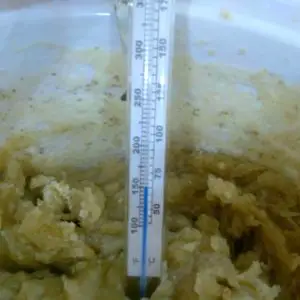This earthy, citrusy lemongrass soap may not only create an invigorating shower experience and contribute to healthy skin, but it also has aromatherapeutic properties. It contains lemongrass oil as well as ground lemongrass blades for gentle exfoliation.
Lemongrass essential oil has been shown to have antimicrobial properties, this makes it effective against acne and even dandruff. In addition, it acts as an astringent, that helps to tighten pores and remove excess oils from the surface of the skin and is a great insect repellant especially against pesky mosquitoes.
Some aromatherapists believe that there are benefits to inhaling certain essential oils in the shower, especially when warm water is being used, as the steam helps to open the airways and improve inhalation. Lemongrass essential oil in aromatherapy is also said to relieve anxiety and depression and may be effective in enhancing mood.
I was gifted a soapmaking kit by Emerging Green, a company based in Singapore that focuses on environmentally friendly products, conservation and sustainability.
As I intended to make a smaller quantity of lemongrass soap than my usual batches, this kit was perfect as the mold has a capacity of 1.98 pounds.
The kit comes with:
- 1 stainless steel wire cutter with wooden base
- 1 wooden soap mold frame
- 1 purple silicone mold
- 1 wooden cover lid
I particularly like this kit for creating smaller batches. The cutter is certainly an upgrade from my kitchen knife! It cuts the soap perfectly with all the bars being even, as there are measurements to guide the sizing. I believe it is a great starter kit for beginner soapmakers as well.
I made this soap using the hot process method. One of the pros of using this method is that the soap can be used much sooner than cold process soaps.
So, a few months ago while chatting with my friend on the phone, she casually mentioned to me that she was about to trim her lemongrass plant as it was getting too big, then she sent me the following picture.

When she indicated that she already had enough to make tea for herself and her family and asked if I would like some, my first thought was; when life gives you lemongrass, make lemongrass soap – of course! 🙂
So, after obtaining lemongrass from my friend, I rinsed the blades, lay them out to dry on a flat clean surface and once the water evaporated, I put them in an open box to continue drying. I let them dry for four months until the grass blades were crisp.

The next step was to cut them into pieces so that they could fit into my mini chopper and grind to as fine a powder as possible.



The smell of this freshly ground lemongrass was amazing!
If you are unable to dry and grind your own lemongrass (or your friend’s) you may be able to purchase pure lemongrass tea from your local supermarket and use the contents of one or two teabags. Depending on the coarseness of the tea, you may have to grind it further.
Here’s how to make this hot process lemongrass soap.
Ingredients
- 7 oz Coconut oil
- 7 oz Olive oil
- 1 oz Castor oil
- 1 oz Cocoa butter
- 2.35 oz Sodium Hydroxide
- 6.10 oz Distilled water
- 1/2 tablespoon ground lemongrass
- 0.5 oz Lemongrass oil
Directions to Make Lemongrass Soap
The first step is always to suit up for safety when making soap. Put on your safety glasses, long sleeves and gloves. Ensure that your soap making area is prepared with all your tools and that no children or pets are around.
Set your slow cooker on high and add the cocoa butter after weighing to allow it time to melt.

Next, weigh your oils and add them to the slow cooker.


In a plastic container, weigh the sodium hydroxide.

Weigh the water, in a stainless steel or heat-proof container.
In a well-ventilated area, carefully add the sodium hydroxide to the water, in that order, and stir it well with a stainless steel spoon until properly dissolved. Be careful not to inhale the fumes that are given off by the solution.

Once the lye is fully dissolved, add it to the slow cooker with the oils and melted cocoa butter.

Using an immersion blender, bring the soap batter to a thick trace.

Then cover the pot and let it cook for about 15 minutes before checking on it.

Depending on the heat of your slow cooker, you should start to see separation after 15 to 20 minutes.

Using a silicone spatula or stainless steel spoon (be careful not to scrape the slow cooker), stir the soap to mix all the textures together. Cover the pot again and leave for another 15 to 20 minutes, after which the soap should reach the applesauce stage.

Stir the soap again, cover and let cook for another 15 to 20 minutes. The next stage is the ‘Vaseline’ stage. At this stage, the soap should take on an appearance similar to petroleum jelly and will have a shiny sheen.

Once the ‘Vaseline’ stage is achieved, the soap is finished cooking. Turn off the cooker and uncover. The next step is to incorporate the additives.

The flashpoint of lemongrass essential oil is 160 degrees Fahrenheit. If it is added when the soap is above this temperature, most of the oil will evaporate, so it is best to allow the soap to cool to just below 160 degrees before adding the essential oil. You also do not want the soap to cool too much or it will start to harden. Use an infrared or candy thermometer to monitor the temperature.

At 150 degrees I added the ground lemongrass as well as the lemongrass oil. Stir well to incorporate and ensure that all the oil is mixed in properly.

Next, scoop all the soap into the mold and give the mold a few firm taps on the counter to remove any air spaces.

Cover the mold and set aside to cool. You can leave overnight and cut it the following day, or you can put it in the fridge for a few hours until it is firm enough to cut.

Once the soap is firm, cut them into bars according to your preference.


This soap can be used right away, but to have them last longer in the shower, it is best to let them sit for about two weeks to continue to harden before using.
Enjoy using your refreshing lemongrass soap!
Happy soaping!! 🙂



I am loving the details!
Thank you, Sal 😉
Wow, after I made this I realized this is *way too much essential oil for the amount of soap. I have a similar soap mold with the same dimensions but I could clearly see this was not enough soap for it. My batch fit into the 4×4 silicone sample mold from Brambleberry and made 4 bars at 4oz each. They are extremely fragrant and I will have to rebatch them as the EO content is over the recommended safe amount for hot process soap. Using this recipe, the max Lemongrass EO content is 0.24oz.
https://www.eocalc.com/enter-your-own-blend/
Hi, Kaycee.
Thanks for your input. Using the same calculator that you provided with Hot Process Soap (Category 9) selected for 16ounces of oil, the usage for a ‘Strong’ fragrance is 0.48oz. It can indeed be too strong for some people and the calculator gives recommendations for usage amounts based on the desired strength. Also the extraction process and quality of essential oils can affect the final product and certainly a factor in the usage percentage. I always recommend that the usage as directed by the manufacturer be used and a test batch created. Some manufacturers and guidelines for certain essential oils such as Lemongrass suggest a usage up to 0.8ounces PPO (per pound of oils) which is far over the recommended limit suggested in the calculator you’ve provided. Again, I always refer to the manufacturers guidelines and the MSDS sheet if available.